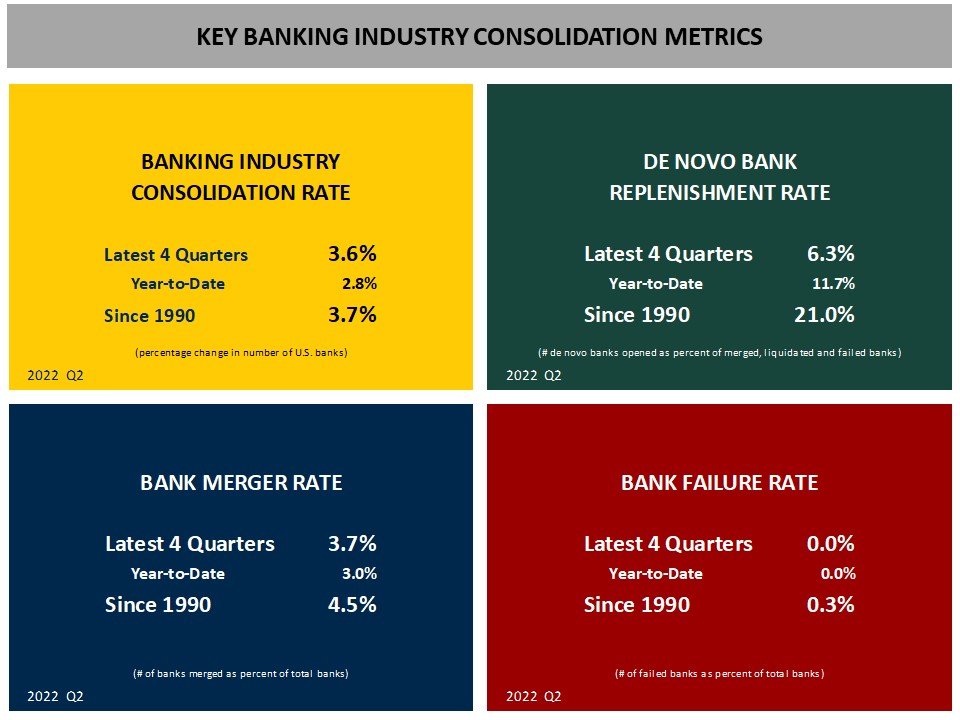THROUGH THREE QUARTERS OF 2022, THE BANKING INDUSTRY CONSOLIDATION CONTINUES TO BE LOWER THAN HISTORICAL AVERAGES. AND, FOR THE LATEST 4 QUARTERS, THE PACE OF CONSOLIDATION ALSO FELL SLIGHTLY BELOW HISTORICAL AVERAGES.
Banking Industry Consolidation Rate = 3.4% for L4Q, but only 2.6% for the three quarters of 2022. Both stats are below the historical average since 1990 of 3.7%.
Bank Merger Rate = 3.5% for L4Q, but only 2.7% for the three quarters of 2022. Both stats are below the historical average since 1990 of 4.4%.
Bank Failure Rate = 0.0% for L4Q with no bank failures and reflecting on the strength of the banking industry. The historical average since 1990 is 0.3%.
De Novo Bank Replenishment Rate = 6.7% for L4Q, and 11.4% through three quarters of 2022 - primarily reflecting lower merger activity. Both stats are below the historical average since 1990 of 21.0%.
BANK CHARTERS:
Overall, the number of U.S. banks fell to 4,746 at the end of Q3 2022 - down 168 from one year ago.
The largest declines continued to occur in Community Banks with less than $500 million in total assets.
And the largest declines of headquartered banks continues to occur in rural markets with populations of less than 50 thousand.
BANKING INDUSTRY CONSOLIDATION RATE:
Banking industry consolidation net activity slowed during 2022. The Banking Industry Consolidation Rate for the three quarters of 2022 was 2.6%, which compares to 3.4% for the L4Q . The historical average was 3.7% since 1990.
Community banks consolidated at a rate of 3.5% L4Q with several states showing a consolidation rate of 4% or higher: Missouri, Illinois, Iowa, California, Texas, Oklahoma, Kansas, New York, and Florida.
BANK MERGER RATE:
Bank merger activity slowed from significantly during 2022. The Bank Merger Rate for YTD 2022 was 2.7%, which compares to 3.5% for the L4Q . The historical average was 4.4% since 1990.
DE NOVO BANK REPLENISHMENT RATE:
De novo banking activity remains historically low with approximately 11 new charters annually. The De Novo Bank Replenishment Rate was 6.7% for L4Q, or approximately 7 new banks opened to replace every 100 banks lost to merger, failure or liquidation. This rate remains well below the historical average or 21.0%, or 21 new banks opened to replace every 100 banks lost to merger, failure or liquidation.
BANK FAILURE RATE:
There were no bank failures for the L4Q ending Q2 2022. Hence, the Bank Failure Rate was 0.0%.
Over 770 days have past since the last bank failure.
Financially, the industry is sound. Earnings were solid. Credit quality continues to look good. And capital levels remain strong.
2022 - 2023 OUTLOOK:
The pace of banking industry consolidation is expected to continue below historic averages.
This pace will result from a below average rate for bank mergers. There is no reason to believe that any unusual resurgence will occur.
The bank failure rate should continue to remain near zero.
And de novo bank activity will continue at less than 10 per year with the de novo bank replenishment rate in the 5-10% range.





























